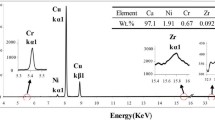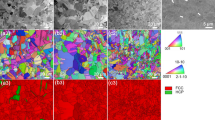Abstract
A series of CuZr binary alloys with wide composition range were fabricated through ARB and HPT techniques using pure Cu and Zr metals as the starting materials. Bulk alloy sheets with thickness of about 0.8 mm after ARB process and alloy disks with 0.30 mm in thickness and 10 mm in diameter after HPT process can be obtained, respectively. The structures of all the alloys were found to be gradually refined with the increase of ARB cycles or HPT rotations. As a result, nanoscale multiple-layered structure was formed for the 10 cycled ARBed specimens, which could partially transform into amorphous phase during subsequent low temperature annealing. While for the as-HPTed sample, the alloy was completely amorphized after 20 rotations without any heat treatment. The thermal stabilities of the amorphous alloys were studied. The deformation behavior and the amorphization mechanism during the ARB and HPT process were put forward and discussed.









Similar content being viewed by others
References
Johnson WL (1999) MRS Bull 24:42
Chen HS (1980) Rep Prog Phys 43:353. doi:https://doi.org/10.1088/0034-4885/43/4/001
Valiev RZ, Islamgaliev RK, Alexandrov IV (2000) Prog Mater Sci 45:103. doi:https://doi.org/10.1016/S0079-6425(99)00007-9
Langdon TG (2006) Rev Adv Mater Sci 11:34
Saito Y, Utsunomiya H, Tsuji N (1999) Acta Mater 47:579. doi:https://doi.org/10.1016/S1359-6454(98)00365-6
Sagel A, Sieber H, Fecht HJ (1998) Acta Mater 46:4233. doi:https://doi.org/10.1016/S1359-6454(98)00097-4
Wilde G, Rosner H (2007) J Mater Sci 42:1772. doi:https://doi.org/10.1007/s10853-006-0986-7
Atzmon M, Verhoeven JD, Gibson ED (1984) Appl Phys Lett 45:1052. doi:https://doi.org/10.1063/1.95064
Hsieh PJ, Huang JC, Hung YP (2004) Mater Chem Phys 88:364. doi:https://doi.org/10.1016/j.matchemphys.2004.08.002
Ohsaki S, Kato S, Tsuji N (2007) Acta Mater 55:2885. doi:https://doi.org/10.1016/j.actamat.2006.12.027
Sun YF, Tsuji N, Kato S (2007) Mater Trans 48:1605. doi:https://doi.org/10.2320/matertrans.MJ200735
Hellstern E, Schultz L (1986) Appl Phys Lett 48:124. doi:https://doi.org/10.1063/1.96971
Stolyarov VV, Gunderov DV, Popov AG, Gaviko VS, Ermolenko AS (1998) J Alloy Compos 281:69. doi:https://doi.org/10.1016/S0925-8388(98)00774-9
Sergueeva AV, Song C, Valiev RZ, Mukherjee AK (2003) Mater Sci Eng A 339:159
Revesz A, Hobor S, Labar JL, Zhilyaev AP, Kovacs Z (2006) J Appl Phys 100:103522. doi:https://doi.org/10.1063/1.2388868
Huang JY, Zhu YT, Liao XZ, Valiev RZ (2004) Philos Mag Lett 84(3):183. doi:https://doi.org/10.1080/09500830310001657353
El-Eskandarany Sherif M, Inoue A (2002) Metal Mater Trans 33:2145. doi:https://doi.org/10.1007/s11661-002-0046-0
Schwarz RB, Johnson WL (1983) Phys Rev Lett 51:415. doi:https://doi.org/10.1103/PhysRevLett.51.415
Zhang Q, Lai WS, Yang GW (2002) J Phys Condens Matter 12:6991. doi:https://doi.org/10.1088/0953-8984/12/31/301
Chu JP, Liu CT, Wang SF (2004) Phys Rev B 69:113410. doi:https://doi.org/10.1103/PhysRevB.69.113410
Wang D, Li Y, Sun BB (2004) Appl Phys Lett 20:4029. doi:https://doi.org/10.1063/1.1751219
Xu D, Duan G, Johnson WL (2004) Phys Rev Lett 92:245504. doi:https://doi.org/10.1103/PhysRevLett.92.245504
Inoue A, Zhang W (2004) Mater Trans 45:584. doi:https://doi.org/10.2320/matertrans.45.584
Xu D, Lohwongwatana B, Duan G (2004) Acta Mater 52:2621. doi:https://doi.org/10.1016/j.actamat.2004.02.009
Tang MB, Zhao DQ, Pan MX (2004) Chin Phys Lett 21:901. doi:https://doi.org/10.1088/0256-307X/21/4/001
Acknowledgement
The present study was financially supported by the Grant-in-Aid for Scientific Research on Priority Area “Materials Science of Bulk Metallic Glasses” and the Global COE program “Center of Excellent for Advanced Structural and Functional Materials Design” in Osaka University both through MEXT, Japan.
Author information
Authors and Affiliations
Corresponding author
Rights and permissions
About this article
Cite this article
Sun, Y.F., Todaka, Y., Umemoto, M. et al. Solid-state amorphization of Cu + Zr multi-stacks by ARB and HPT techniques. J Mater Sci 43, 7457–7464 (2008). https://doi.org/10.1007/s10853-008-2634-x
Received:
Accepted:
Published:
Issue Date:
DOI: https://doi.org/10.1007/s10853-008-2634-x




